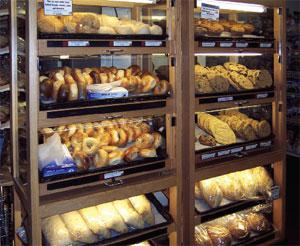Bread Program Makes the Co-op a Neighborhood Destination

Is there anything better than warm, crusty bread? The smell, the texture, the burst of flavor when you break it open and dip it into a little bit of olive oil and a good balsamic…
At the Lexington Cooperative Market in Buffalo, N.Y., fresh, crusty bread has been making us a neighborhood destination for the past 15 years. This article is about how we have built our program out of a postage-stamp-size kitchen into one of the leading departments in our store.
First, a little bit about our co-op. We are a 4,500-square-foot store located in the Elmwood Village neighborhood of Buffalo. Elmwood Village has about 30,000 residents and in 2007 was named one of America’s 10 Great Neighborhoods by the American Planning Association.
Our success has always come from the combined focus of being a corner store that provides the community with high-quality conventional produce, bread, and dairy, as well as a destination natural foods store that draws people from Western New York. Our customer counts are high—1,200 per day—and our average basket size is low at $17. In other words, we get a lot of people stopping by on their way home to pick up a few things for dinner—which makes crusty bread a natural fit for our customer. But which came first, the convenience customer or the crusty bread that lured them in? I haven’t been around long enough to answer that.
Origins and numbers
Until 2005, we were located in a 1,200-square-foot storefront off the main drag. We had no kitchen, so in 1996 we partnered with a local restaurant to get fresh-baked, crusty bread daily. I’m not going to say it was all about the bread, but our total sales grew from $800,000 in 1996 to $2.1 million in 2005 and are now up to $7 million.
We currently sell an average of 140 loaves per day—meaning that more than 10 percent of our customers buy a loaf of bread. We charge $3.99 per loaf and make a 35 percent margin. In the past three months, par-baked breads accounted for nearly 2.5 percent of store sales, with another 4 percent of store sales comes from other baked goods produced on-site—cookies, scones, muffins, cakes, etc. And while overall store sales grew at 7.5 percent over the past three months, bakehouse sales grew at 32 percent. People want comfort food.
How we do it
We buy Ecce Panis par-baked breads. They are relatively “clean” and have one organic option. There are probably other lines out there that have more whole grain and organic options. Since we sell about 140 loaves per day, the availability of daily deliveries was a strong criterion in selecting Ecce Panis. On Saturday, our freezer is stuffed with boxes of par-baked breads waiting for the Sunday rush. We have a single two-door convection oven for our entire operation. The loaves take only 10–15 minutes to finish, so we can keep the display abundant and fresh from open to close with very little labor or shrink. We give the par-baked bread five 4’ shelves in our bread racks.
In addition to par-baked breads, we have built our bakehouse business around simple, delicious treats made with organic ingredients. We don’t skimp on the butter and sugar. We sell seven dozen cookies per day, plus two dozen brownies and a few dozen other bars and treats. We also do a good breakfast business, selling on average 90 bagels, 40 muffins and 40 scones per day. While we do carry special-diet items like vegan crisp rice treats and gluten-free cookies, 80 percent of our sweets sales come from standard recipes: chocolate chip cookies, fudge brownies, scones, and muffins.
The bakehouse production space is limited to a 6’ table that is directly across from the two-door convection oven. We have two baker shifts per day, and total bakehouse daily sales are $1,200.
So, if your store is a daily destination for last-minute dinner assemblers—or it has the potential to lure people in with hot, fresh bread, but you don’t have the room for a from-scratch bakery just yet—we recommend scaling up with a par-baked program. You won’t regret it.







